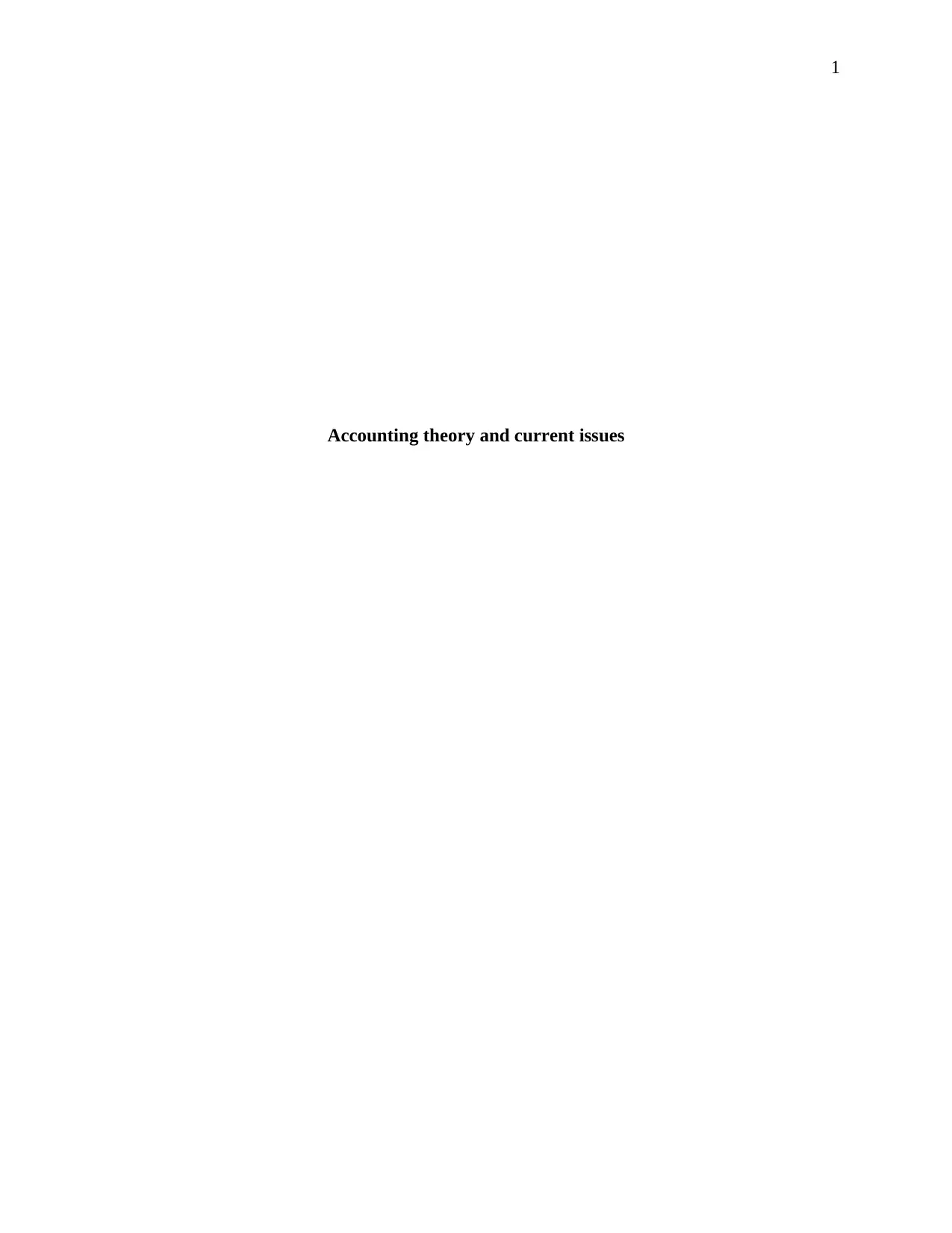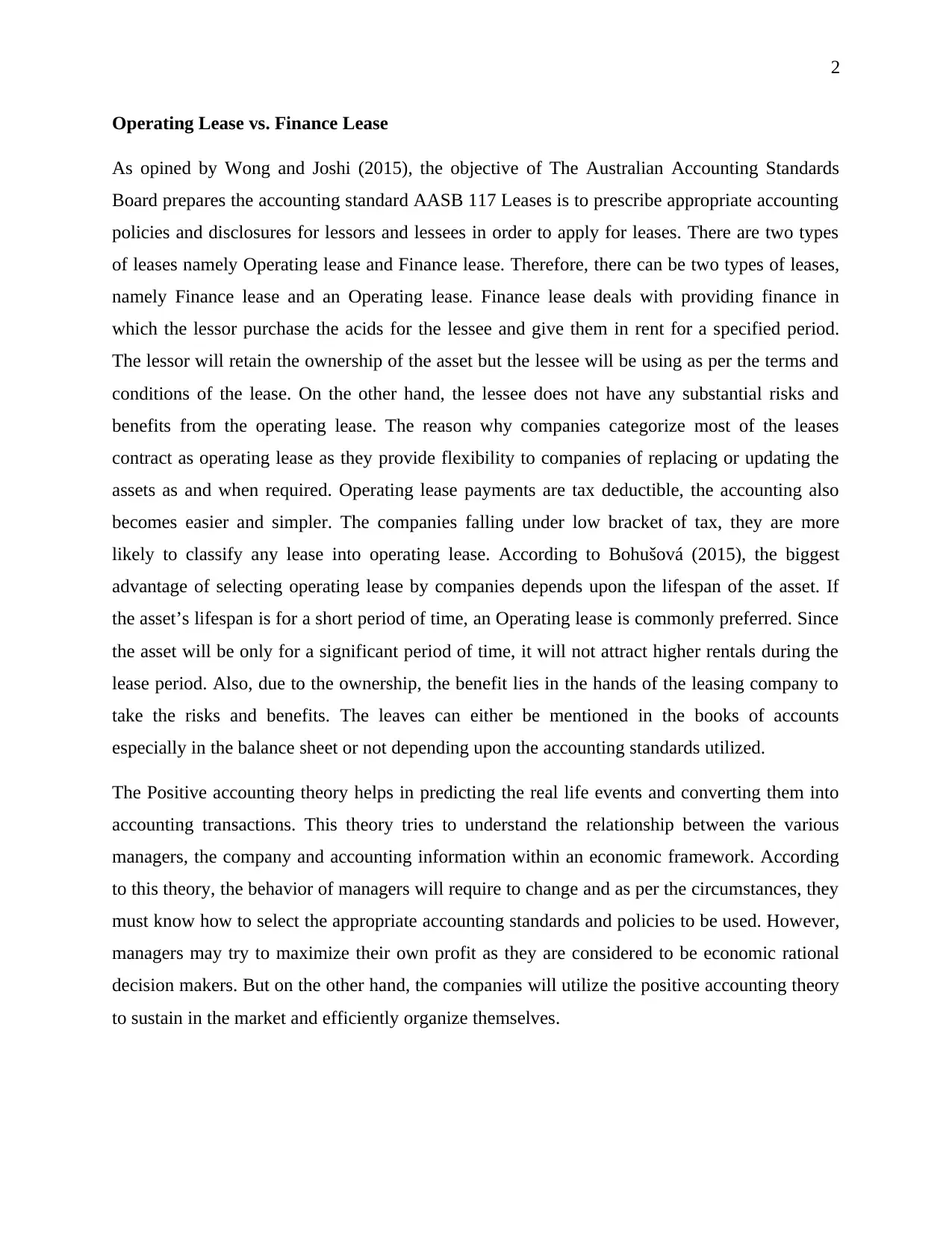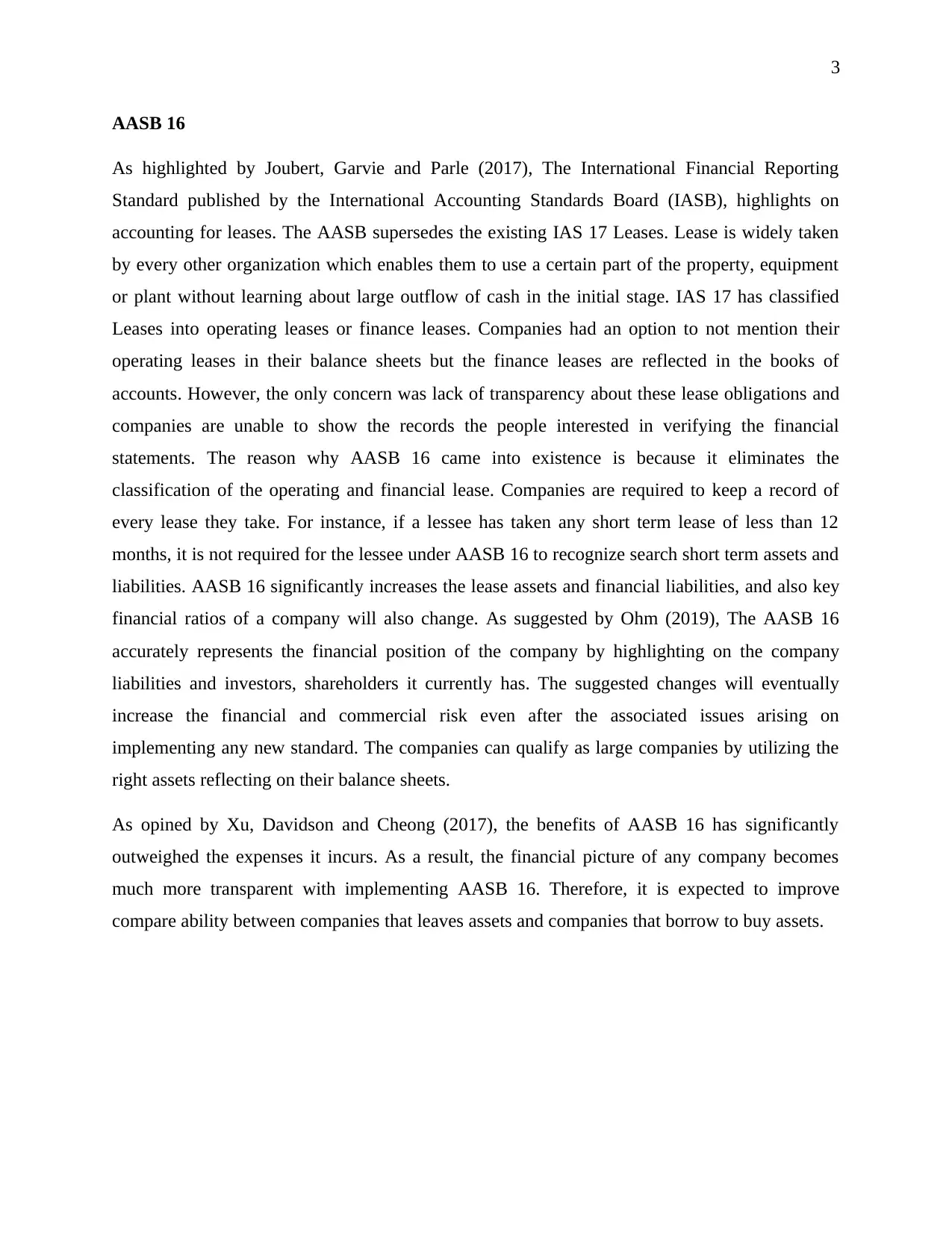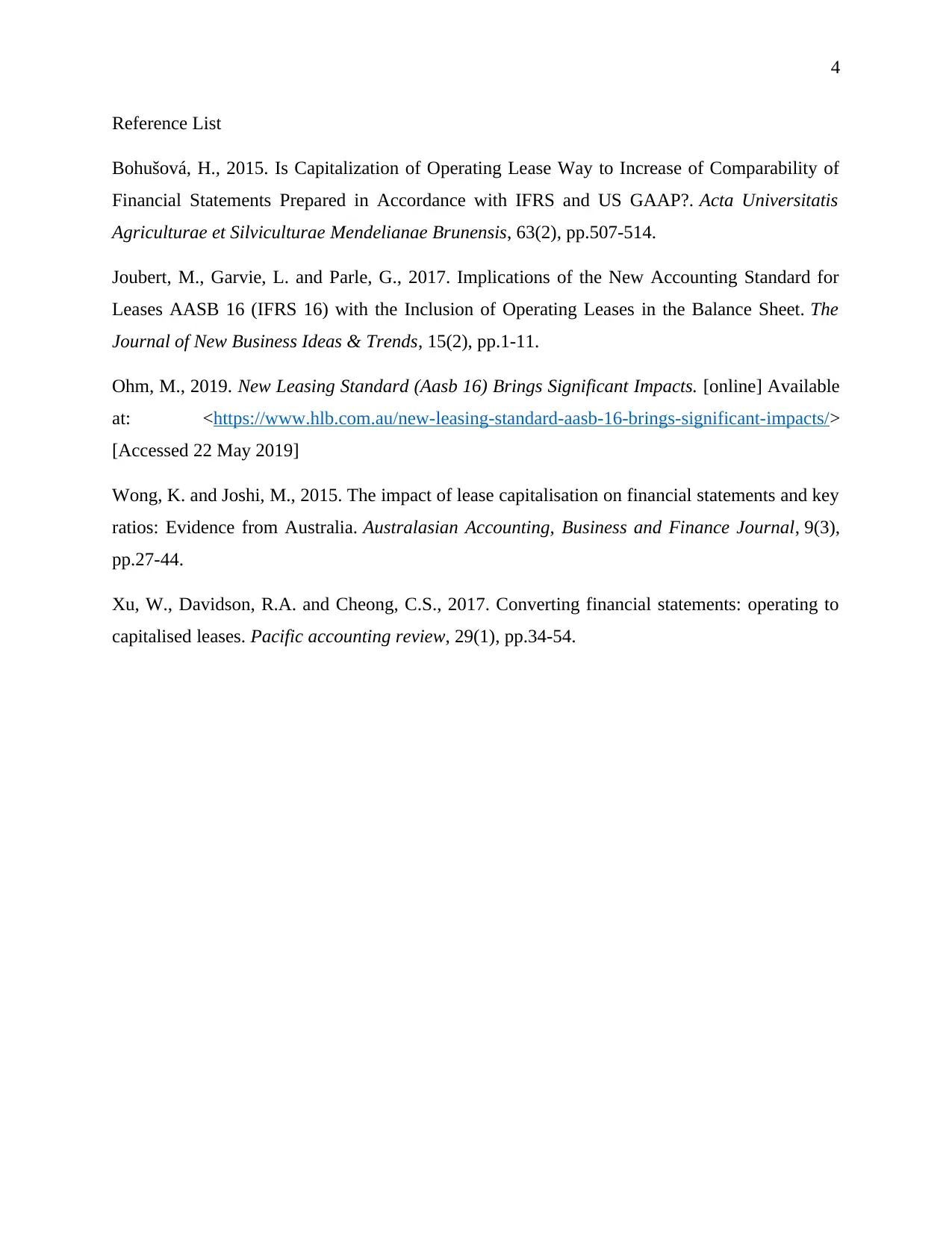Accounting Standards: Operating vs. Finance Lease, Theory and Issues
VerifiedAdded on 2022/11/13
|4
|1053
|489
Report
AI Summary
This report delves into the intricacies of operating and finance leases, exploring the motivations behind companies' lease classifications under the former accounting standard AASB 117, where they often favored operating leases. It examines the role of positive accounting theory in influencing managerial decisions regarding lease selection, highlighting how managers may aim to maximize their own benefits by choosing specific accounting standards. Furthermore, the report analyzes the impact of AASB 16, the new standard, emphasizing its objective to enhance comparability between companies that lease assets and those that purchase them. The analysis provides insights into how AASB 16 aims to increase transparency by eliminating the classification of operating and finance leases, requiring companies to record all leases and thus providing a more accurate representation of a company's financial position. The report uses references to support its findings.

1
Accounting theory and current issues
Accounting theory and current issues
Paraphrase This Document
Need a fresh take? Get an instant paraphrase of this document with our AI Paraphraser

2
Operating Lease vs. Finance Lease
As opined by Wong and Joshi (2015), the objective of The Australian Accounting Standards
Board prepares the accounting standard AASB 117 Leases is to prescribe appropriate accounting
policies and disclosures for lessors and lessees in order to apply for leases. There are two types
of leases namely Operating lease and Finance lease. Therefore, there can be two types of leases,
namely Finance lease and an Operating lease. Finance lease deals with providing finance in
which the lessor purchase the acids for the lessee and give them in rent for a specified period.
The lessor will retain the ownership of the asset but the lessee will be using as per the terms and
conditions of the lease. On the other hand, the lessee does not have any substantial risks and
benefits from the operating lease. The reason why companies categorize most of the leases
contract as operating lease as they provide flexibility to companies of replacing or updating the
assets as and when required. Operating lease payments are tax deductible, the accounting also
becomes easier and simpler. The companies falling under low bracket of tax, they are more
likely to classify any lease into operating lease. According to Bohušová (2015), the biggest
advantage of selecting operating lease by companies depends upon the lifespan of the asset. If
the asset’s lifespan is for a short period of time, an Operating lease is commonly preferred. Since
the asset will be only for a significant period of time, it will not attract higher rentals during the
lease period. Also, due to the ownership, the benefit lies in the hands of the leasing company to
take the risks and benefits. The leaves can either be mentioned in the books of accounts
especially in the balance sheet or not depending upon the accounting standards utilized.
The Positive accounting theory helps in predicting the real life events and converting them into
accounting transactions. This theory tries to understand the relationship between the various
managers, the company and accounting information within an economic framework. According
to this theory, the behavior of managers will require to change and as per the circumstances, they
must know how to select the appropriate accounting standards and policies to be used. However,
managers may try to maximize their own profit as they are considered to be economic rational
decision makers. But on the other hand, the companies will utilize the positive accounting theory
to sustain in the market and efficiently organize themselves.
Operating Lease vs. Finance Lease
As opined by Wong and Joshi (2015), the objective of The Australian Accounting Standards
Board prepares the accounting standard AASB 117 Leases is to prescribe appropriate accounting
policies and disclosures for lessors and lessees in order to apply for leases. There are two types
of leases namely Operating lease and Finance lease. Therefore, there can be two types of leases,
namely Finance lease and an Operating lease. Finance lease deals with providing finance in
which the lessor purchase the acids for the lessee and give them in rent for a specified period.
The lessor will retain the ownership of the asset but the lessee will be using as per the terms and
conditions of the lease. On the other hand, the lessee does not have any substantial risks and
benefits from the operating lease. The reason why companies categorize most of the leases
contract as operating lease as they provide flexibility to companies of replacing or updating the
assets as and when required. Operating lease payments are tax deductible, the accounting also
becomes easier and simpler. The companies falling under low bracket of tax, they are more
likely to classify any lease into operating lease. According to Bohušová (2015), the biggest
advantage of selecting operating lease by companies depends upon the lifespan of the asset. If
the asset’s lifespan is for a short period of time, an Operating lease is commonly preferred. Since
the asset will be only for a significant period of time, it will not attract higher rentals during the
lease period. Also, due to the ownership, the benefit lies in the hands of the leasing company to
take the risks and benefits. The leaves can either be mentioned in the books of accounts
especially in the balance sheet or not depending upon the accounting standards utilized.
The Positive accounting theory helps in predicting the real life events and converting them into
accounting transactions. This theory tries to understand the relationship between the various
managers, the company and accounting information within an economic framework. According
to this theory, the behavior of managers will require to change and as per the circumstances, they
must know how to select the appropriate accounting standards and policies to be used. However,
managers may try to maximize their own profit as they are considered to be economic rational
decision makers. But on the other hand, the companies will utilize the positive accounting theory
to sustain in the market and efficiently organize themselves.

3
AASB 16
As highlighted by Joubert, Garvie and Parle (2017), The International Financial Reporting
Standard published by the International Accounting Standards Board (IASB), highlights on
accounting for leases. The AASB supersedes the existing IAS 17 Leases. Lease is widely taken
by every other organization which enables them to use a certain part of the property, equipment
or plant without learning about large outflow of cash in the initial stage. IAS 17 has classified
Leases into operating leases or finance leases. Companies had an option to not mention their
operating leases in their balance sheets but the finance leases are reflected in the books of
accounts. However, the only concern was lack of transparency about these lease obligations and
companies are unable to show the records the people interested in verifying the financial
statements. The reason why AASB 16 came into existence is because it eliminates the
classification of the operating and financial lease. Companies are required to keep a record of
every lease they take. For instance, if a lessee has taken any short term lease of less than 12
months, it is not required for the lessee under AASB 16 to recognize search short term assets and
liabilities. AASB 16 significantly increases the lease assets and financial liabilities, and also key
financial ratios of a company will also change. As suggested by Ohm (2019), The AASB 16
accurately represents the financial position of the company by highlighting on the company
liabilities and investors, shareholders it currently has. The suggested changes will eventually
increase the financial and commercial risk even after the associated issues arising on
implementing any new standard. The companies can qualify as large companies by utilizing the
right assets reflecting on their balance sheets.
As opined by Xu, Davidson and Cheong (2017), the benefits of AASB 16 has significantly
outweighed the expenses it incurs. As a result, the financial picture of any company becomes
much more transparent with implementing AASB 16. Therefore, it is expected to improve
compare ability between companies that leaves assets and companies that borrow to buy assets.
AASB 16
As highlighted by Joubert, Garvie and Parle (2017), The International Financial Reporting
Standard published by the International Accounting Standards Board (IASB), highlights on
accounting for leases. The AASB supersedes the existing IAS 17 Leases. Lease is widely taken
by every other organization which enables them to use a certain part of the property, equipment
or plant without learning about large outflow of cash in the initial stage. IAS 17 has classified
Leases into operating leases or finance leases. Companies had an option to not mention their
operating leases in their balance sheets but the finance leases are reflected in the books of
accounts. However, the only concern was lack of transparency about these lease obligations and
companies are unable to show the records the people interested in verifying the financial
statements. The reason why AASB 16 came into existence is because it eliminates the
classification of the operating and financial lease. Companies are required to keep a record of
every lease they take. For instance, if a lessee has taken any short term lease of less than 12
months, it is not required for the lessee under AASB 16 to recognize search short term assets and
liabilities. AASB 16 significantly increases the lease assets and financial liabilities, and also key
financial ratios of a company will also change. As suggested by Ohm (2019), The AASB 16
accurately represents the financial position of the company by highlighting on the company
liabilities and investors, shareholders it currently has. The suggested changes will eventually
increase the financial and commercial risk even after the associated issues arising on
implementing any new standard. The companies can qualify as large companies by utilizing the
right assets reflecting on their balance sheets.
As opined by Xu, Davidson and Cheong (2017), the benefits of AASB 16 has significantly
outweighed the expenses it incurs. As a result, the financial picture of any company becomes
much more transparent with implementing AASB 16. Therefore, it is expected to improve
compare ability between companies that leaves assets and companies that borrow to buy assets.
⊘ This is a preview!⊘
Do you want full access?
Subscribe today to unlock all pages.

Trusted by 1+ million students worldwide

4
Reference List
Bohušová, H., 2015. Is Capitalization of Operating Lease Way to Increase of Comparability of
Financial Statements Prepared in Accordance with IFRS and US GAAP?. Acta Universitatis
Agriculturae et Silviculturae Mendelianae Brunensis, 63(2), pp.507-514.
Joubert, M., Garvie, L. and Parle, G., 2017. Implications of the New Accounting Standard for
Leases AASB 16 (IFRS 16) with the Inclusion of Operating Leases in the Balance Sheet. The
Journal of New Business Ideas & Trends, 15(2), pp.1-11.
Ohm, M., 2019. New Leasing Standard (Aasb 16) Brings Significant Impacts. [online] Available
at: <https://www.hlb.com.au/new-leasing-standard-aasb-16-brings-significant-impacts/>
[Accessed 22 May 2019]
Wong, K. and Joshi, M., 2015. The impact of lease capitalisation on financial statements and key
ratios: Evidence from Australia. Australasian Accounting, Business and Finance Journal, 9(3),
pp.27-44.
Xu, W., Davidson, R.A. and Cheong, C.S., 2017. Converting financial statements: operating to
capitalised leases. Pacific accounting review, 29(1), pp.34-54.
Reference List
Bohušová, H., 2015. Is Capitalization of Operating Lease Way to Increase of Comparability of
Financial Statements Prepared in Accordance with IFRS and US GAAP?. Acta Universitatis
Agriculturae et Silviculturae Mendelianae Brunensis, 63(2), pp.507-514.
Joubert, M., Garvie, L. and Parle, G., 2017. Implications of the New Accounting Standard for
Leases AASB 16 (IFRS 16) with the Inclusion of Operating Leases in the Balance Sheet. The
Journal of New Business Ideas & Trends, 15(2), pp.1-11.
Ohm, M., 2019. New Leasing Standard (Aasb 16) Brings Significant Impacts. [online] Available
at: <https://www.hlb.com.au/new-leasing-standard-aasb-16-brings-significant-impacts/>
[Accessed 22 May 2019]
Wong, K. and Joshi, M., 2015. The impact of lease capitalisation on financial statements and key
ratios: Evidence from Australia. Australasian Accounting, Business and Finance Journal, 9(3),
pp.27-44.
Xu, W., Davidson, R.A. and Cheong, C.S., 2017. Converting financial statements: operating to
capitalised leases. Pacific accounting review, 29(1), pp.34-54.
1 out of 4
Related Documents
Your All-in-One AI-Powered Toolkit for Academic Success.
+13062052269
info@desklib.com
Available 24*7 on WhatsApp / Email
![[object Object]](/_next/static/media/star-bottom.7253800d.svg)
Unlock your academic potential
Copyright © 2020–2025 A2Z Services. All Rights Reserved. Developed and managed by ZUCOL.

